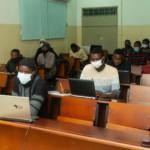
Francis Simui, Eija Laitinen & Satu Määttänen
Reptiles renew their skill regularly. It might feel awkward for us humans. However, in the process of ecdysis, there is a clear purpose and a lot of wisdom. Ecdysis allows reptiles to grow and regenerate (Tu et al., 2002), thus improving their strength and survival abilities. To keep up with the changing world and to adapt to and utilise the constantly accumulating new knowledge, humans also need to shed some old habits and regenerate – figuratively speaking, of course.
In this article, based on our own experiences, we compare the reptiles’ ecdysis to the process of transforming from a traditional teacher to a competent problem-based learning (PBL) mentor. We will provide a brief introduction to PBL and the teacher’s role within, then provide step-by-step guidance to the ecdysis process to become a modern PBL mentor.
Problem-based learning and the teacher’s role
Problem-based learning was originally developed for medical studies more than six decades ago (Servant‐Miklos et al., 2019). Due to its various benefits, PBL has since successfully spread to other disciplines, both at undergraduate and graduate levels (Servant‐Miklos et al., 2019). PBL is associated with the development of so-called generic skills or transformative competencies, such as communication, collaboration, critical thinking, and problem-solving (Abbey et al., 2017; Ding et al., 2014; Tan et al., 2014).
The PBL methodology is based on a constructivist learning approach and student-centrism, meaning that students actively take responsibility for their learning and construct knowledge through experience and reflection (Bada, 2015; Weimer, 2002, p. 15). Compared to the so-called traditional teaching and learning method, i.e., lecturing and memorisation, in PBL students change from passive information recipients to active knowledge creators. Teachers themselves transform from information providers to mentors who facilitate and guide learning (Weimer, 2002, p. 74). Mentors should create a safe learning environment that is conducive to learning and monitor, assess, and provide feedback on the learning process (Abbey et al., 2017; Major & Palmer, 2001). This role change – or ecdysis – is an important process requiring various competencies and attitudes from the teacher (Knuutti & Määttänen, 2023).
The ecdysis process of a PBL mentor
For a successful ecdysis to a PBL mentor, learn from nature’s wonders and follow the below steps.
You need to shred off your skin regularly, or you will be shredded by life. Snakes go through the ecdysis process to remain vibrant and healthy, to grow further, and to remove parasites. Professional teachers, in turn, need to embrace the paramount importance of lifelong learning, both for the students and for the teachers themselves. To produce employable graduates, professional teachers – or mentors – should continuously equip themselves with new tools, methods, and knowledge and change attitudes and teaching methods accordingly. The ecdysis to become a PBL mentor promotes relevant and sustainable learning.
Start the ecdysis from your mindset. To shed their old skin, reptiles start the process from the mouth or nose area by creating a rip in the skin to be shed (Wonderpolis, 2015). A top-down transformation is critical to success. For professional teachers, a deliberate decision to change is a critical part of the transformation process. A teacher must be willing and able to change their mindset, shed old habits and attitudes, and regenerate into a PBL mentor who facilitates rather than dictates learning.
Be ready to explore and expose yourself, don’t compare yourself to others. Ecdysis in a snakeskin usually takes an inside-out approach. For professional teachers, transformation is the time to explore and expose themselves inside out. First, an individual target is determined, and then a strategy is developed to obtain it. Every teacher has their own learning path, and the most suitable learning methods vary by individual.
Take a holistic approach in the ecdysis process. A healthy snake will shed all its skin in one piece, including the eye caps. Becoming a competent PBL mentor is a holistic competence-building process that includes knowledge, skill, and attitude components. A PBL mentor must have a pedagogical understanding of the PBL approach and the theories behind it, as well as practical skills and competencies to implement it. Importantly, teachers must change their attitudes and step down from the position of classroom manager and knowledge provider and instead start to facilitate learning and tolerate the “messiness” related to this process (Weimer, 2002, p. 81).
Retreat to shed off your old skin. Before shedding, a snake’s vision becomes impeded (Pacey, 2022). A safe place to hide is needed. Initially, the PBL methodology can scare the traditional teacher and arouse questions. What is my position in the classroom? Am I respected? How do I position myself in the teaching and learning process? Such insecure thoughts, even initial resistance, are part of the transformation process. To ease and enhance this process, support from management and peers is important (Määttänen et al., 2023; McCowan, 2018)
Accept that vulnerability is linked to the ecdysis. During ecdysis, reptile’s body is soft, making them highly vulnerable. They experience dehydration, have increased chances of being crushed, and their speed is reduced. At this phase, the reptile is at its weakest point. Becoming a PBL mentor takes time and has setbacks and moments of hesitation. A teacher may feel a loss of control and even incompetence in the face of the new method (Määttänen et al., 2023). There may be moments when one wants to give up and wonders why I started this at all. However, proper training, peer support, and dedication will help to pass this stage and achieve a positive outcome.
Enjoy the pain to attain full ecdysis. Ecdysis includes breaching old skin by “rubbing against a rough, hard object, such as a rock or a log” (Wonderpolis, 2015). As a teacher, you should enjoy the pain associated with the change process. Enjoy the ups and downs of your learning process. Most importantly, remember that sometimes mistakes and hardships teach more than constant success.
Cultivate a culture of ecdysis within and around you. Snakes shed their skins about 4–12 times a year, depending on health, diet, and species. Let ecdysis be an integral part of the professional teacher’s success. No matter how well you think you have mastered the PBL methods, be prepared to renew yourself through continuous professional development. The beauty is that your colleagues and peers are close to you and your best coaches and support.
Beware of disecdysis. Disecdysis is the abnormal shedding of skin that can be caused by a variety of factors and can manifest in various forms. To avoid disecdysis in your professional community, help others to shed off their old skins and to regenerate in a reciprocal process: support others, and you will be supported.
The benefits of the ecdysis process
After the ecdysis process, embrace your new PBL mentor identity and the change brought upon you. Remember that the ecdysis is an ongoing process, as PBL mentorship changes over time. Be prepared to encounter students who master some topics better than you do. Yet, you will have so much to give to them, especially when it comes to means of support, guidance, and motivation building.
From our own experience, we can admit that the ecdysis from a traditional teacher to a PBL mentor may be challenging. Yet, we can also guarantee that it will be highly rewarding – both for you as the educator and also for your students. As a competent PBL mentor, you will be able to teach your students skills that enable them to land a job or even start their own business. The benefits of PBL are not limited to the individual level but may pass through the whole society. Competent and skilled graduates will become future changemakers who can contribute to solving pressing global and local challenges and building a better world for all of us.
Authors
Francis Simui, Ph.D in Philosophy (Inclusive Education), Associate Professor of Inclusive Education at the University of Zambia.
Eija Laitinen, Ph.D. in Adult Education, Principal Research Scientist at the HAMK Bio Research Unit. She is the AgriSCALE and PBL-BioAfrica Project Coordinator and leads the HAMK Africa Team.
Satu Määttänen, M.Sc. in Agricultural Sciences and M.Sc. in Environmental Science and Policy from the University of Helsinki. She works as a Project Expert at the HAMK Bio Research Unit.
References
Abbey, Lord, Dowsett, E., & Sullivan, J. (2017). Use of problem-based learning in the teaching and learning of horticultural production. Journal of Agricultural Education and Extension, 23(1), 61–78. https://doi.org/10.1080/1389224X.2016.1202846
Bada, S. O. (2015). Constructivism Learning Theory: A Paradigm for Teaching and Learning. IOSR Journal of Research & Method in Education, 5(6), 66–70. https://doi.org/10.9790/7388-05616670
Ding, X., Zhao, L., Chu, H., Tong, N., Ni, C., Hu, Z., Zhang, Z., & Wang, M. (2014). Assessing the effectiveness of problem-based learning of preventive medicine education in China. Scientific Reports, 4(1), 5126. https://doi.org/10.1038/SREP05126
Knuutti, U.-M., & Määttänen, S. (2023). What makes a good mentor in problem-based learning? HAMK Beat, 15.3.2023. https://blog.hamk.fi/hamk-beat/what-makes-a-good-mentor-in-problem-based-learning/
Määttänen, S., Knuutti, U.-M., & Laitinen, E. (2023). Transformation towards problem-based learning in East and Southern Africa: Perceptions from the field. African Journal of Rural Development, 7(2), 167–175. https://afjrd.org/index.php/jos
Major, C. H., & Palmer, B. (2001). Assessing the Effectiveness of Problem-Based Learning in Higher Education: Lessons from the Literature. Academic Exchange Quarterly, 5(1), 4. http://www.rapidintellect.com/AEQweb/mop4spr01.htm
McCowan, T. (2018). Quality of higher education in Kenya: Addressing the conundrum. International Journal of Educational Development, 60, 128–137. https://doi.org/10.1016/j.ijedudev.2017.11.002
Pacey, P. (2022). Snakes Shedding Their Skins (or Moulting or Sloughing). Whole Earth Education. https://wholeeartheducation.com/snakes-shedding-skin/
Servant‐Miklos, V. F. C., Norman, G. R., & Schmidt, H. G. (2019). A Short Intellectual History of Problem‐Based Learning. In W. Hung, M. Moallem, & N. Dabbagh (Eds.), The Wiley Handbook of Problem‐Based Learning (pp. 3–24). John Wiley & Sons. https://doi.org/10.1002/9781119173243.CH1
Tan, D. K., Koppi, A., & Field, D. J. (2014). The student perspective in developing graduate attributes through problem-based learning in first year agricultural science. Proceedings of The Australian Conference on Science and Mathematics Education, 170–175. https://openjournals.library.sydney.edu.au/index.php/IISME/article/view/7784
Tu, M. C., Lillywhite, H. B., Menon, J. G., & Menon, G. K. (2002). Postnatal ecdysis establishes the permeability barrier in snake skin: new insights into barrier lipid structures. Journal of Experimental Biology, 205(19), 3019–3030. https://doi.org/10.1242/JEB.205.19.3019
Weimer, M. (2002). Learner-centered teaching: five key changes to practice (1st ed.). Jossey-Bass.
Wonderpolis. (2015). Why Do Snakes Shed Their Skin? https://wonderopolis.org/wonder/why-do-snakes-shed-their-skin





